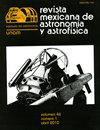k星中钛谱线的微分红移
IF 1.7
4区 物理与天体物理
Q3 ASTRONOMY & ASTROPHYSICS
Revista Mexicana de Astronomia y Astrofisica
Pub Date : 2022-10-01
DOI:10.22201/ia.01851101p.2022.58.02.01
引用次数: 0
摘要
我们使用平分线追踪技术对K型恒星样本的UVES光谱中的线核位置进行了测量。在除两颗外的所有恒星中,我们都检测到Ti I线相对于Fe I线的过度红移。我们援引线深度的温度依赖性来解释这一点。我们得出的结论是,颗粒化曲线不是唯一的,而是取决于化学物质。本文章由计算机程序翻译,如有差异,请以英文原文为准。
THE DIFFERENTIAL REDSHIFT OF TITANIUM LINES IN K STARS
We present measurements of line core positions in UVES spectra of a sample of K-type stars, using the technique of bisector tracing. In all but two of these stars we detect an excess redshift of Ti I lines with respect to Fe I lines. We explain this invoking the temperature-dependence of the line depths. We conclude that the granulation curve is not unique but depends on the chemical species.
求助全文
通过发布文献求助,成功后即可免费获取论文全文。
去求助
来源期刊

Revista Mexicana de Astronomia y Astrofisica
地学天文-天文与天体物理
CiteScore
1.30
自引率
10.00%
发文量
14
审稿时长
>12 weeks
期刊介绍:
The Revista Mexicana de Astronomía y Astrofísica, founded in 1974, publishes original research papers in all branches of astronomy, astrophysics and closely related fields. Two numbers per year are issued and are distributed free of charge to all institutions engaged in the fields covered by the RMxAA.
 求助内容:
求助内容: 应助结果提醒方式:
应助结果提醒方式:


